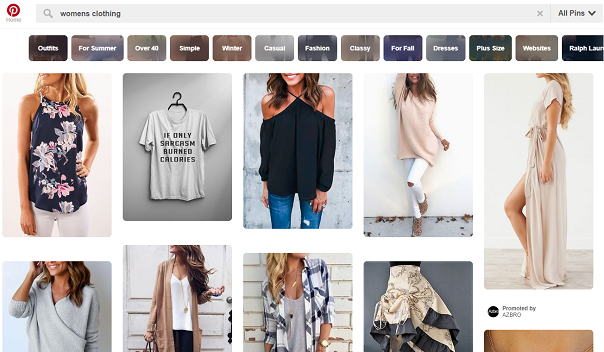There are millions of people on Pinterest, searching, pinning, and sharing – so it’s important to recognize its potential for building awareness and filling the top of the funnel, particularly for ecommerce companies.
This blog will discuss a couple of recommended targeting types within Pinterest to help fill the top of the funnel and essentially build up your audience. From there, once your audience is built out, we’ll run through how to actually capitalize on these new users to drive sales.
Let’s jump in.
Use Pinterest to fill the funnel
Pinterest has some specific features that are highly effective for building your audience. These include:
Keyword targeting
You can leverage user intent by targeting specific keywords that users are searching within Pinterest.
For example, if you are a trendy clothing brand that sells sweaters, you may want to target “trendy sweaters” and have your ad (in Pinterest lingo, your promoted pin) show up in the search results and related pins.
Interest targeting
Pinterest will determine a user’s interest based on the pins they have engaged with and saved. Your ad (promoted pin) will show up in the user’s home feed or relevant topics feed.
A Promoted Pin on Pinterest
“Actalike” targeting
This is similar to Facebook’s lookalike targeting; you can upload a customer list and Pinterest will target audiences similar in behaviors, traits, and characteristics as that customer list. Our recommendation is to start off with your top customers – for example, your highest-LTV or AOV audiences.
I would initially recommend prioritizing the Actalike and keyword targeting as they tend to be more effective at getting in front of highly relevant audiences. But by leveraging any or all of the targeting options, you’re discovering and engaging with new, relevant audiences and driving them to your site.
That said, make sure your expectations are aligned. You should not expect to see Pinterest as a lever for immediate purchases, but more as a longer-term play where you’re developing an awareness and building your audience to hit later via a few different methods below to actually drive the sale.
That said, let’s talk about how to…
Convert Pinterest engagement into sales
Now that you’ve engaged with your audiences via Pinterest, you should be capturing those audiences for remarketing purposes.
First, to be smart with your remarketing efforts and truly understand the value of Pinterest, you should make sure every link on your Pinterest ads include a tag that labels it as Pinterest. You can use UTM parameters or anything else, but essentially you want to make sure that you can identify these audiences that have come through from Pinterest and segment them out.
You can then create specific audiences within both Google and Facebook (for example) that have come in through Pinterest. (E.g. url contains ‘utm_source=pinterest). Now you can separate out these audiences, and as you use them in your retargeting strategies, you can understand if the Pinterest audiences you have built are actually converting into sales.
Speaking of converting, I’d recommend the following methods:
RLSA (remarketing for search ads)
Layer your Pinterest audiences onto existing search campaigns and add a higher bid modifier. These audiences have already visited your site and developed a familiarity with your brand. If they end up searching for your product, you want to make sure your ad appears high in the search results to remind them of your brand, pull them to your site, and entice them to convert.
One RLSA strategy I’d recommend is to create a separate “broad” RLSA campaign where you can bid on head terms, and broader but still relevant terms that you normally wouldn’t be able to afford.
For example, you typically may not bid on a term like “womens clothing” because it is so generic and has heavy competition, but given the user has already visited your site, you can create an RLSA campaign, layer your Pinterest audiences, and bid on the term.
The thought behind this is that by serving your ad on this more generic keyword, you are reminding them that you sell women’s clothing. Since the users have been to your site, they’ll have a sense of if it’s worth visiting. Essentially, this is way of getting in front of relevant eyes without doing significant harm to overall efficiency.
Dynamic remarketing
You can do this on both Facebook and GDN where ads include the product the user has visited on the site (as well as other relevant products). The usual segmentation caveats apply; you want to make sure you’re segmenting by time lapsed since the visit and depth of site pages reached and bid accordingly.
Remarketing for shopping
Make use of your audience list by layering it onto your shopping campaigns. Again, the goal here is to bid more aggressively so you can ensure your ad shows up for the audiences who have engaged with your Pinterest ad, visited the site, and developed familiarity with the brand. You’ll typically see higher CVRs for these types of audiences.
The main takeaway here: if you’re not investing in Pinterest, you’re missing out on engaging a robust, potentially high-ROI audience. The platform itself has come a long way in adding marketing-friendly features and reporting capabilities to position itself as a long-term player. Get on board now; the traffic’s not getting any cheaper.
Good luck!
For more on how to integrate Pinterest into your sales strategy, check out our visual guide to Pinterest advertising.
source https://searchenginewatch.com/2017/07/18/the-2-step-guide-to-driving-sales-with-pinterest/


No comments:
Post a Comment